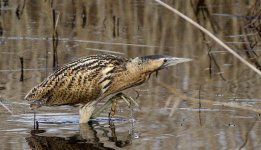Remembered yesterday to follow Tim's advice ( make sure you've got a fast speed dialled in to counter any negative effect the high pixels might have).Had to dial in ISO 1600 for this shot to get a fast speed which was new ground for me never going above ISO 800 with the 40D.Quite pleased with the result.
Max.
It's not that the smaller pixels have a negative effect. The only concern is that the smaller pixels, being able to resolve more detail, are also able to resolve blur/shake more easily too. At the
image level a file from a 7D shot at 1/1000 will have the same amount of blur/shake as an image shot at 1/1000 from a 30D, 40D or 50D as well. At the
pixel level, 7D photos may show up shake/blur that the cameras with larger pixels simply don't reveal.
So the 7D doesn't need faster shutter speeds than the other cameras, but you may see no benefit from the higher resolution either, if you don't use faster speeds. Balancing pixel level shake/blur vs pixel level noise is a fine art and the right solution will depend on the individual circumstances for each picture. Certainly it is true that noise is easier to fix in an image than blur, but there is no need to go mad with shutter speed either. To maintain equivalent levels of blur, per pixel, a 7D would need shutter speeds 34% higher than those for a 40D. But if you are not scrutinising individual pictures then you probably don't need a higher shutter speed with the 7D. Using a tripod, monopod or IS lens should help reduce the need for such high shutter speeds, although there is still subject blur/motion to consider.
For the bittern picture above, which is essentially moving quite slowly (not a BIF) I would suspect that 800 ISO and 1/1500 might have been a better choice, but whether that is true or not depends on many things. With a tripod then 400 ISO and 1/750 should have been even better. Maybe even 200 ISO and 1/375 would have been better still.
Please remember that these guidelines about shutter speeds and focal lengths vary depending not only on the individual's own abilities to hold the camera steady, but also on the final size at which the image is viewed and from what distance it is viewed. Going back to the original guideline.....
For a 35mm frame printed/displayed at a size of 10"x8", shutter speed should be at least 1/focal length, for viewing from 12" away.
From that premise you can work out the shutter speed you need in order to render a visibly shake free image from other sensor sizes and other display sizes. If we assume use of a 400mm lens, that gives us some examples as follows....
400mm on full frame, printed/displayed at 10x8 requires SS >= 1/400
400mm on APS-H, printed/displayed at 10x8 requires SS >= 1/500
400mm on APS-C, printed/displayed at 10x8 requires SS >= 1/640
If you were to display such images for the web, without cropping, at half the size above -i.e. as a 5"x4" image on screen, then you would only need shutter speeds half as fast as the guidline figures above.
In contrast, if you were to make prints of 20"x16" or so then you would need to double the shutter speeds shown above, for viewing from 12" away. If you were to view 7D files at 100%, that would yield an image of somewhere around 40"x27", requiring shutter speeds 4X greater than the guideline speeds above. 40D files, viewed at 100%, would only need shutter speeds around 3X greater than the guidline speeds above.
If you first crop your images, thus making them smaller then you change the calculations again. In effect, cropping your images is the just the same as changing your crop factor. The more you crop, the higher the shutter speed you need for any given final image display size.
So, for pixel peeping, or extreme cropping, 1/3000 might well be in order, but for viewing at more normal magnification levels, 1/1000 ought to be more than adequate, unless you really struggle with stability, or your subjects are exceptionally lively. Of course, at 1/1000, wing blur can often be significant, although not without its appeal, so 1/1000 probably makes for a good shutter speed to aim for, for general bird photography. That's not to say that there is no place for 1/250, 1/6400, or anything else in between or even beyond those figures. It all depends.
In fact, to cut to the chase, it is not the camera, the sensor, or the pixel density that drives the need for a given shutter speed. What matters is how much you enlarge the captured image and from how far away you view it.





